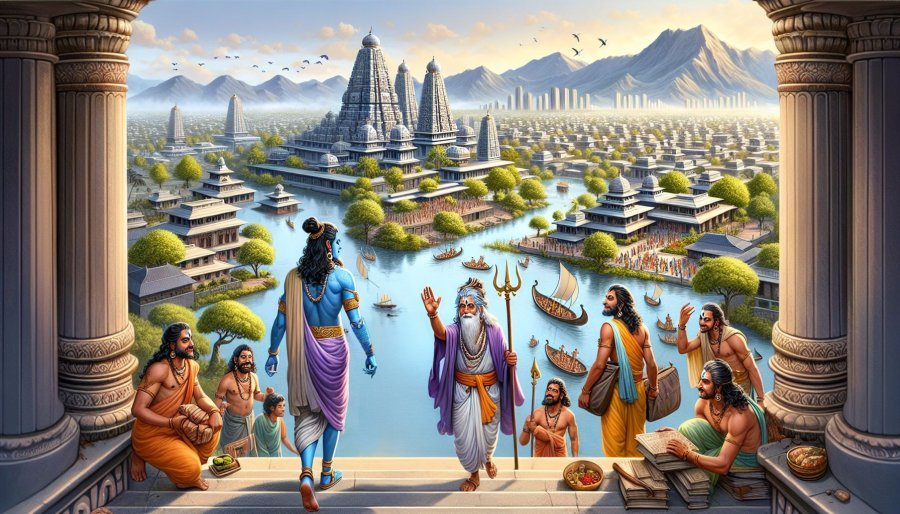Section CCIX [summary]
Book index: Mahabharata (English)
This page contains a summary of the Mahabharata Section CCIX including examples of moral lessons in daily life. The Maha-Bharata is one of the largest epics ever written containing roughly 100,000 Sanskrit verses. It deals with the legendary history of ancient India and contains a large number of interwoven tales.

Short summary of the chapter:
The Pandavas, along with Krishna and Vidura, journeyed to Hastinapura, where they were warmly received by the citizens. Dhritarashtra advised them to settle in Khandavaprastha to avoid conflicts with their cousins, offering them half the kingdom. The Pandavas accepted the offer and moved to Khandavaprastha, where they built a magnificent city called Indraprastha, adorned with luxurious palaces and gardens. The city became a hub of prosperity, attracting Brahmanas, merchants, and skilled artisans, making it a prosperous and thriving place. With the help of Bhishma and Drupada, the Pandavas established themselves securely in their new kingdom without fear of harm.
Full English translation:
This page is merely a summary which is automatically generated. If you are looking for authentic sources such as the Sanskrit text or the Full English translation of Mahabharata Section CCIX, have a look at the following articles:
Section CCIX, online text
English translation by Kisari Mohan Ganguli.
Read this and other chapters online.
Mahabharata (English Summary)
by Kisari Mohan Ganguli | ISBN-10: 8121505933
Buy the latest edition:
FAQ of Section CCIX:
What was the reason for the Pandavas to move to Khandavaprastha?
The Pandavas were advised by King Dhritarashtra to move there to prevent any future conflicts with their cousins. It was also a way for them to have a peaceful rule with half of the kingdom.
How did the Pandavas beautify the city of Khandavaprastha?
They performed propitiatory ceremonies, measured out a piece of land, surrounded the city with a trench and high walls, and adorned it with palatial mansions, gates, and numerous weapons of defense.
Why is Indraprastha compared to Amaravati and Indra's city?
The city was beautifully laid out with wide streets, numerous mansions, and delightful gardens filled with various trees. It was a prosperous and wealthy city that resembled a heavenly abode.
Who came to dwell in Indraprastha after its construction?
Numerous Brahmanas well-versed in the Vedas, merchants, skilled artisans, and people proficient in various arts came to live in the city. The surroundings were adorned with gardens, lakes, and ponds, attracting a diverse population to the prosperous city.
Mahabharata Section CCIX in daily life:
This story, rich in the lore of the Mahabharata, teaches us about resilience, cooperation, and the value of moral guidance. These lessons can be seamlessly incorporated into our daily lives to enhance our personal and professional relationships, as well as our self-growth.
First, the Pandavas' journey to build Indraprastha from a desert illustrates the power of resilience and vision. Similarly, we can approach our challenges with determination, envisioning success despite initial setbacks. This story encourages us not to be deterred by difficult starts but to view them as opportunities for remarkable achievements.
The role of wise counselors like Vidura and the support of allies such as Krishna emphasizes the importance of seeking and valuing wise advice and cooperation. In our lives, this translates to appreciating mentors and forming supportive networks, fostering environments where everyone can thrive through mutual assistance and shared wisdom.
Drupada's readiness to support the Pandavas, relinquishing immediate gains for long-term well-being, underscores the significance of selflessness and foresightedness in leadership and relationships. Applying this, we learn the importance of considering the broader impact of our decisions and prioritizing collective well-being over personal short-term benefits.
The enthusiastic reception of the Pandavas by the citizens of Hastinapura upon their return demonstrates the lasting impact of good leadership and moral integrity on a community. We are reminded to lead by example, nurturing trust and respect through our actions, thereby inspiring those around us.
Finally, the Pandavas' celebration of their achievements without forgetting their duty to their subjects highlights the balance between ambition and responsibility. In our pursuits, it's vital to balance our aspirations with our duties to our community, ensuring that our successes contribute positively to the broader society.
Implementing these teachings encourages a balanced life, fostering resilience, cooperation, wise counsel, selflessness, and responsible ambition. By embracing these principles, we can cultivate fulfilling relationships and make meaningful contributions to our communities.
